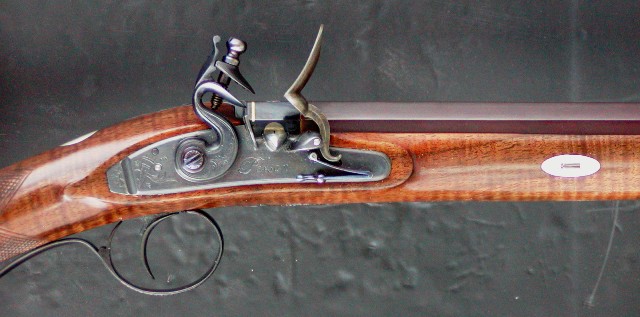Unmentioned is what sort of hunting will you be doing? I have followed dogs on foot all day and an extra pound of gun weight is a misery. I have followed dogs in a jeep as they put up rabbits and gun weight was no issue. It's no issue still hunting unless you are hiking miles to your blind. An 8.3 pound rifle is a heavy gun for a 67 YO arthritic body to tote long distances. At age 74, I am acutely aware of this.
Right now I am barely O.K.
If my plans to lose some weight work out, then the osteoarthritis might not be as bothersome as it is now.
What I am looking for in a new flintlock rifle is the following....
1. Sub-7 pounds
2. Caliber that will penetrate both gristle sheilds of a large wild hog
3. Gain twist that will utilize either a patched ball, or a light-for-caliber conical ( ie. Lee R.E.A.L)
Item Number 1:
There are no stock barrels from Colerain, Rice, or Green Mountain that fit the light weight category. Therefore, a custom modification on a standard pattern is the cheapest way to proceed. I have spoken to Scott, at Colerain, and he is willing to modify a standard, 31" long, "C"-weight Jaeger barrel into a shorter length.
Item Number 2:
Having zero experience shooting wild hogs, I have to rely on the experiences of fellow members here. Howie1968 seems to feel that his .58 caliber, Thompson/Center, Big Boar, percussion rifles loaded with patched balls shoot through the big hogs that he hunts on the regular, as well as anything else that he has hunted hogs with, centerfire, or black powder.
Most .58 caliber barrels, even swamped octagon ones, are going to make for 8-9 pound rifles.
That's why, on reflection, I have decided not to go with a Kibler Colonial kit. It will be too heavy for my long-term needs. It might work right now, but down the road, too heavy.
Item Number 3:
Gain twist. Most people have no experience with a gain twist, and those that do seem to be ambivalent about it.
OTOH, Scott at Colerain has sold close to a thousand of their gain twist barrels over the past 10 years. Little information is on the internet, or muzzleloading forums, regardless of how many of the barrels are out there being used. The two most popular calibers lately seem to be the .40 caliber, and the .58 caliber.
So, what I am thinking of doing is having a 27" long, "C"-weight, swamped, octagon-round, .58 caliber, Jaeger rifle barrel made by Colerain.
Breech = 11" long = 1.062"
Waist = 11" long = 0.776"
Flared Muzzle = 5" long = 0.956"
This would remove 1" from the breech section, 1" from the waist section, and 2" from the flared muzzle section of a 31" barrel.
Colerain is rifling all of their gain twist barrels with a rate of twist that finishes at the muzzle at 1:36". This is regardless of whether the caliber is .40, .45, .50, .54, .58, or .62. Colerain does not produce a gain twist in .36 caliber.
Originally, the gain twist was only offered in the Classic American pattern, 42" long barrel. With an approximate 2.25:1 ratio gain twist, the rate of twist at the breech in a 42" long barrel, with a 1:36" rate of twist at the muzzle, is 1:81"
The 38" long Early American barrel has an approximate 2.1:1 ratio gain twist, with a rate of twist at the breech of 1:75.6", and a rate of twist at the muzzle of 1:36".
A 27" long, custom Jaeger barrel would have an approximate 1.75:1 ratio gain twist, with a rate of twist at the breech of 1:63", and a rate of twist at the muzzle of 1:36".
I am thinking of an English Sporting Rifle style stock design to mitigate recoil. No buttplate, toeplate, sideplate, entry ramrod pipe, muzzle cap, or rear sight on the barrel. Ambidextrous, with no cheekpiece. A Lowell Haarer-style, tang-mounted, 2-screw, ghost ring, rear sight. Single trigger in a Hawken-length trigger bar. Flint breech plug with a 6" long, beavertail tang that is double-bolted to the trigger bar. English, large-bow, scroll trigger guard.
I will still, in all likelihood, have to wear a shooting vest with ambidextrous recoil-absorbing pads in both shoulders. Whether at the range, or hunting. To protect my osteoarthritic shoulders for as long as possible. And, by shifting from right-handed (my natural side), to left-handed (my almost natural side), every couple of shots.













